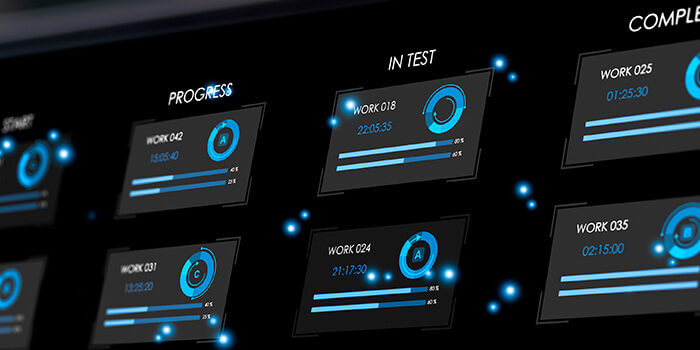It’s Official: RevGen is a Great Place to Work
For our second year, RevGen has been certified as a "Great Place to Work"
Read More About It’s Official: RevGen is a Great Place to Work
AWS and Azure are considered best-in-class for developer tools. So how do they compare to each other?

Author: Luis Martinez
Cloud computing has reshaped the way organizations handle data and operations, putting software development increasingly at the core of how these organizations run. It’s not a stretch to say that boosting developer productivity should be of concern for organizations – but how important is it really?
Research by McKinsey & Co. suggests that the number one driver of business performance is best-in-class developer tools. In this evolving landscape, AWS (Amazon Web Services) and Azure emerge as the Coca-Cola and Pepsi of cloud platforms, each with their distinct offerings and strengths. They both offer a comprehensive suite of tools and services, giving businesses the power to build from virtually anywhere. AWS is well-known for its wide-ranging functionality, scale, and flexibility, while Microsoft Azure is well-known for its excellent integration with other Microsoft products.
Both platforms provide an array of developer tools designed to optimize business processes, bolster productivity, and streamline efficiency. In this article, we’ll provide an overview of some of the standout, productivity-boosting tools available on each platform.
The development environments for both AWS and Azure have been designed to optimize and simplify the development processes, however they vary in their functionality.
Integrated Development Environments (IDEs)
Let’s compare the differences in four key areas: structure and deployment, integrations, portability, and languages and frameworks.
Structure and Deployment:
Integration:
Portability:
Languages and Frameworks:
In summary, while both VS Code and AWS Cloud9 serve as environments for developers to write and debug code, they do have distinct features and cater to slightly different use cases.
It’s also worth discussing additional deployment and support tools from AWS and Azure – these tools are geared towards the automation, integration, and deployment phases of software development, rather than the initial coding phase.
AWS CodeStar
CodeStar is designed to streamline the setup, development, and deployment of applications on AWS. By offering a unified interface, you can easily manage your software development activities all in one place, providing an integrated experience for continuous integration / delivery (CI/CD).
AWS CodeBuild, CodeDeploy, and CodePipeline
These services automate the build, test, and deployment phases of your release process, ensuring consistent and reliable application updates. CodeBuild, a continuous integration (CI) service, can compile source code, run tests, and produce software packages that are ready to deploy on a dynamically created build server.
CodeDeploy, automates software deployments to a variety of compute services such as Amazon’s EC2, AWS Lambda, and even to your on-premises servers.
CodePipeline is a fully managed continuous delivery (CD) service that can automate the release pipelines for fast and reliable application updates. CodePipeline brings it all together to create an end-to-end pipeline that fetches application code, builds and test using CodeBuild, and deploy using CodeDeploy.
AWS Lambda
Lambda lets developers run code without provisioning or managing servers, which can significantly streamline application development and reduce complexity. Lambda can be triggered from over 200 AWS services and software-as-a-service (SaaS) applications, and you only pay for what you use.
AWS Amplify & SAM (Serverless Application Model)
AWS Amplify is a complete solution that facilitates the building of cloud-enabled mobile and web applications, providing libraries, UI components, and a command-line interface.
SAM, on the other hand, is an open-source framework for building serverless applications, offering a shorthand syntax for describing serverless resources. With a combination of built-in best practices, simplified deployments, policy templates, and more, SAM abstracts away much of the boilerplate and routine setup processes associated with serverless applications.
Azure DevOps
Similarly, DevOps is a comprehensive suite offering developer services for CI/CD, agile planning, source code repositories, and application monitoring. It streamlines the end-to-end development process, ensuring faster release cycles and high-quality software. We previously discussed the benefits of a well-designed DevOps platform here.
Azure Resource Manager (ARM) Templates
ARM Templates allow developers to define and deploy infrastructure as code. In the template, you specify the resources to deploy and the properties for those resources. This ensures consistent, repeatable deployments and makes environment setups and duplication more manageable.
Azure Bicep
Bicep is a domain-specific language (DSL) that simplifies the (at times) complex and detailed nature of ARM templates by offering a more user-friendly and streamlined way to achieve the same tasks. Instead of dealing directly with the intricate details of ARM templates, users interact with a more straightforward interface or language (Azure Bicep), which then translates into those detailed ARM templates behind the scenes. It’s similar to using a simplified remote control with only a few buttons, even though the device it controls might have numerous intricate settings and configurations.
By understanding the nuances of each platform’s developer tools, you can make an informed decision tailored to your specific needs and preferences.
At a broader level, when faced with the decision between AWS and Azure, it’s essential to look beyond the surface and dive deep into the specific requirements of your business. Here are some common considerations with respect to the platforms themselves:
Business Needs / Tech Stack
If your business primarily uses Microsoft products (like Office 365, Windows Server, or SQL Server), Azure might be the better option due to its native integrations and potential cost savings from bundling services. On the other hand, if your business already has substantial applications or systems built on open-source software, or you’re looking for a wider variety of service offerings, AWS might be a more natural fit.
Cost
Budget undoubtedly plays a factor in technological decisions. In this area both platforms offer ways to mitigate expense; AWS offers a pay-as-you-go model that can be beneficial for startups and businesses with fluctuating needs. Azure, while also providing a pay-as-you-go model, often extends cost benefits and discounts to existing Microsoft users.
Available Skills
Your organization’s existing and growing expertise should also be considered. If your technical team is already proficient in PowerShell or other Microsoft tools, the learning curve for Azure might be gentler. Conversely, if your team is more Linux-oriented or has significant experience in the AWS ecosystem, then AWS might be the more straightforward option.
Scalability
Both platforms offer robust scalability options. Given AWS’s longer presence in the market, it can be argued that it has a broader global reach, which might be crucial for businesses targeting international audiences. However, Azure is catching up fast and could be preferred if you anticipate integrating with other Microsoft services.
Security
Security protocols are vital. AWS and Azure both provide comprehensive security features, but your specific needs can tip the scale one way or another. For instance, if you’re dealing with specific compliance requirements, you’ll want to research which platform offers better support for those standards.
This was the case for a recent healthcare client looking for a cost-effective, compliant, and scalable cloud solution. RevGen worked with key client stakeholders to evaluate cloud platforms, architectures, and solutions, assembling a solution that is secure and scalable – read more here.
In some scenarios, the decision might be clear-cut based on existing infrastructures or specific requirements. However, in many cases, a detailed evaluation, considering all factors collectively, is crucial to determine the optimal platform and developer tools for your needs.
The overarching reason to highlight these AWS tools as productivity boosters is that they reduce the administrative overhead and number of mundane tasks that developers often face. By abstracting away infrastructure management, automating pipelines, and providing integrated development environments, AWS allows developers to focus on what they do best: coding.
The value proposition for Azure developer tools lies in their tight integration with one another and the broader Azure ecosystem. They eliminate much of the operational overhead and let developers focus more on innovation and coding, less on managing infrastructure and tooling. The tools’ ability to cater to both small applications and enterprise-level solutions ensures that developers of all scales benefit from productivity gains.
These are just a narrow sampling of developer tools and considerations for only the two industry leaders, and deliberately focused on improving developer productivity. We have previously discussed the importance of emerging low-code / no-code offerings by various companies, and we encourage you to learn more about how they have the potential to revolutionize the software development life cycle.
Enhancing developer productivity and efficiency is not just a technical objective, but a business imperative. By harnessing the right developer tools from AWS or Azure, organizations can supercharge their development processes, ultimately leading to improved business performance. Both AWS and Azure bring a treasure trove of tools tailored for various needs, each promising significant gains for developers.
If you’re contemplating how your organization can quickly capitalize on these powerful tools, reach out to one of RevGen’s experts who can guide you through the cloud landscape, ensuring your choices align with your business objectives. To learn more about the services we offer, visit our Technology Services site.

Get the latest updates and Insights from RevGen delivered straight to your inbox.